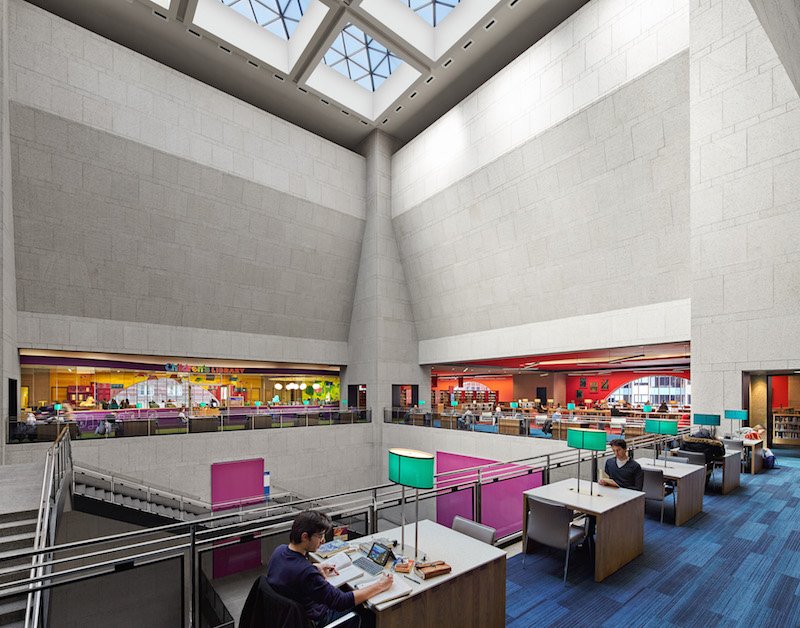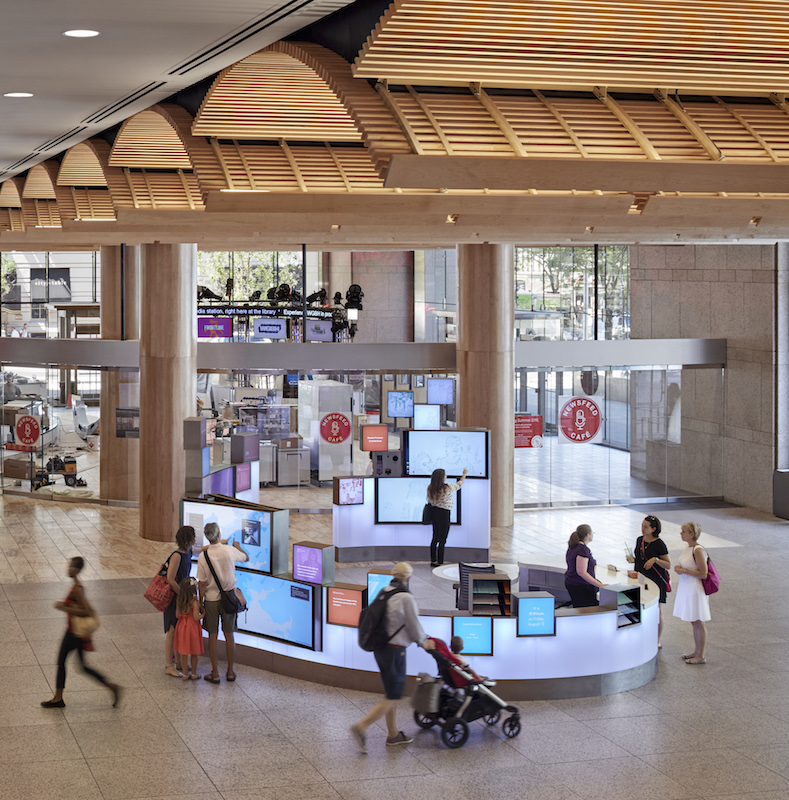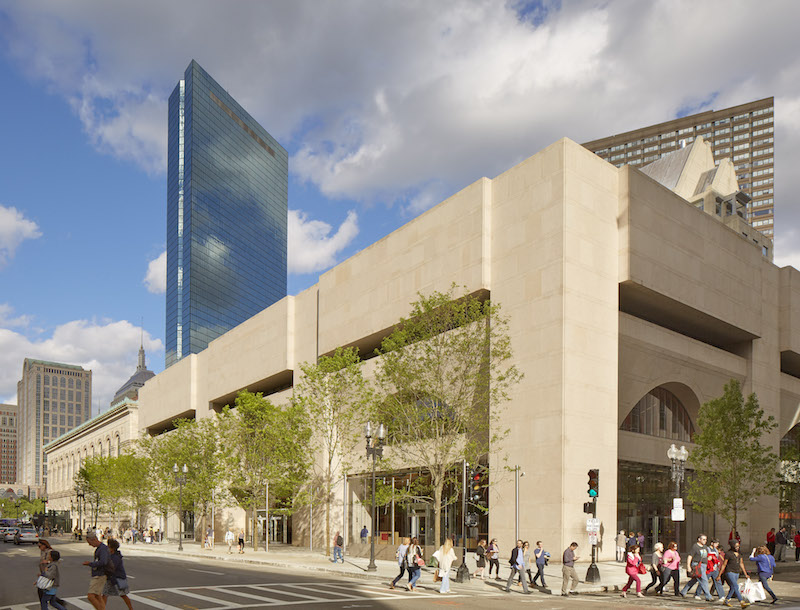About 1.5 million people visited the Boston Public Library between July 2016 and March 2017. That’s a 22% increase over what the library drew from July 2015 through March 2016.
That bump was attributable, in large measure, to the library’s $78 million renovation, the results of which debuted in July 2016. This three-year-long project, lead by William Rawn Associates | Architects and Consigli Construction, opened up and brightened what, by consensus, had been an uninviting space for patrons, disconnected from its Copley Square neighborhood.
The renovation—whose numerous accolades include, most recently, the 2017 Preservation Massachusetts, Paul and Niki Tsongas Award—achieved that goal in several ways.
Most notably, it created a 35-ft-wide, 210-ft-long connection between Johnson Building—a building designed by architect Phillip Johnson and opened in 1972—and the McKim Building, designed by Charles McKim and opened in 1892. Johnson was on record saying that he was never satisfied with the way the entrance and lobby to his building turned out. Neither were visitors who often found themselves wandering through labyrinthine corridors to get from one part of the library to the other.
“People were always getting lost,” said Cliff Gayley, a Partner with William Rawn Associates, who with Sindu Meier, a Senior Associate of the firm; and Phil Brault, Senior Project Manager with Consigli, recently spoke with BD+C about their work on transforming the library.
 The second-floor renovation of Boston's Central Library doubled the size of the Children's library, and created quiet reading spaces around its periphery. The library's atrium, Deferrari Hall, provides ample natural sunlight. Image: Robert Benson Photography.
The second-floor renovation of Boston's Central Library doubled the size of the Children's library, and created quiet reading spaces around its periphery. The library's atrium, Deferrari Hall, provides ample natural sunlight. Image: Robert Benson Photography.
The master plan for this landmark library’s overhaul was drawn up in 2012, soon after which “it became clear very quickly that the building had been designed for a different time,” recalled Meier.
To create a more logistically elegant pathway between the two buildings, the Building Team needed to support the McKim Building’s load-bearing but fragile masonry wall with structural framing and shoring that could withstand a load of over 1 million pounds.
The team devised a steel framing system, preloaded with hydraulic jacks, which allowed for the removal of two concrete columns below the second floor that each handled a load of over 300,000 pounds.
The renovation also removed ugly tinted windows that offered virtually no outside view, as well as 97 granite plinths that formed a barrier around the Johnson building. In their place is a more amenable façade of two-story-high windows that, at ground level, is flush with the sidewalk, making the building appear more approachable from the street.
A movable tunnel system from Boylston Street allowed the library to stay open during construction. The Building Team hauled in building materials through second-floor windows during the renovation, which was conducted in two phases
The first, which was completed in February 2015, spruced up the second floor by doubling the size of the Children’s library, introducing a maker space for teenagers, and creating reading and classroom areas around the perimeter.
Phase two, completed in the summer of 2016, revitalized the lower floor’s Kirsten Business Library and Innovation Center. The entrance to the newly created two-story Boylston Hall offers a Welcome Center and circulation desk (moved back about 75 feet from the door, said Gayley), with informational touch screens that, among other things, allow visitors to peruse the library’s digital catalog.

The newly created Boylston Hall leads visitors to a glass-enclosed area with a cafe and a satellite studio for WGBH. It was important to library officials that the renovation include a retail component. Image: Robert Benson Photography
 A Welcome Center at the library's entrance offers a digital experience to visitors. Image: Robert Benson Photography
A Welcome Center at the library's entrance offers a digital experience to visitors. Image: Robert Benson Photography
That Boylston Street entrance, encompassed by glass, leads visitors to the library’s Newsfeed Café, managed by Catered Affair; as well as a “new and novel” section for fiction and nonfiction, and a satellite television studio for WGBH, Boston’s public station. “Libraries are struggling to remain relevant, and this project exhibits forward thinking and entrepreneurship,” observed Brault. A fetching curved wood-slatted ceiling accents this area.
A total of 156,000 sf were added or improved by this renovation, which included making activities on each floor visible and transparent via Deferrari Hall, the Central Library’s striking atrium, which bathes its more-open and colorful spaces in natural light from the library’s roof.
Related Stories
| Aug 11, 2010
Community college’s hillside learning center
The Earl E. and Dorothy J. Dellinger Learning Resource Center at Southwest Virginia Community College in Richlands, Va., is the centerpiece of this mountainside school. Designed by Arlington, Va.-based The Lukmire Partnership, the 50,000-sf, two-story building connects the upper and lower campuses, which are separated by a 70-foot vertical grade change.
| Aug 11, 2010
BIG beats out Foster and Hadid in design competition for Kazakhstan's National Library
Invited as one of five pre-selected architect-led teams that included Lord Norman Foster and Zaha Hadid, Copenhagen-based BIG was awarded first prize in an international design competition for the new National Library in Astana, Kazakhstan. The 33,000-square-meter facility will be organized as a “circular loop of knowledge” that allows for clear, intuitive orientation of the vast co...
| Aug 11, 2010
Modest recession for education construction
Construction spending for education expanded modestly but steadily through March, while at the same time growth for other institutional construction had stalled earlier in 2009. Education spending is now at or near the peak for this building cycle. The value of education starts is off 9% year-to-date compared to 2008.
| Aug 11, 2010
Concrete Solutions
About five or six years ago, officials at the University of California at Berkeley came to the conclusion that they needed to build a proper home for the university's collection of 900,000 rare Chinese, Japanese, and Korean books and materials. East Asian studies is an important curriculum at Berkeley, with more than 70 scholars teaching some 200 courses devoted to the topic, and Berkeley's pro...
Cultural Facilities | Aug 11, 2010
12 major trends in library design
Many academic planners assumed that the coming of the Internet would lead to the decline of the library as we know it. To the contrary, many academic libraries have experienced significantly increased patron use in recent years.
| Aug 11, 2010
Giants 300 University Report
University construction spending is 13% higher than a year ago—mostly for residence halls and infrastructure on public campuses—and is expected to slip less than 5% over the next two years. However, the value of starts dropped about 10% in recent months and will not return to the 2007–08 peak for about two years.
| Aug 11, 2010
Let There Be Daylight
The new public library in Champaign, Ill., is drawing 2,100 patrons a day, up from 1,600 in 2007. The 122,600-sf facility, which opened in January 2008, certainly benefits from amenities that the old 40,000-sf library didn't have—electronic check-in and check-out, new computers, an onsite coffeehouse.
| Aug 11, 2010
Fleet Library, Rhode Island School of Design
When tasked with transforming an early 1920s Italian Renaissance bank building into a fully functional library for the Rhode Island School of Design, the Building Team for RISD's Fleet Library found itself at odds with the project's two main goals. On the one hand, the team would have to carefully restore and preserve the historic charm and ornate architectural details of the landmark space, d...








